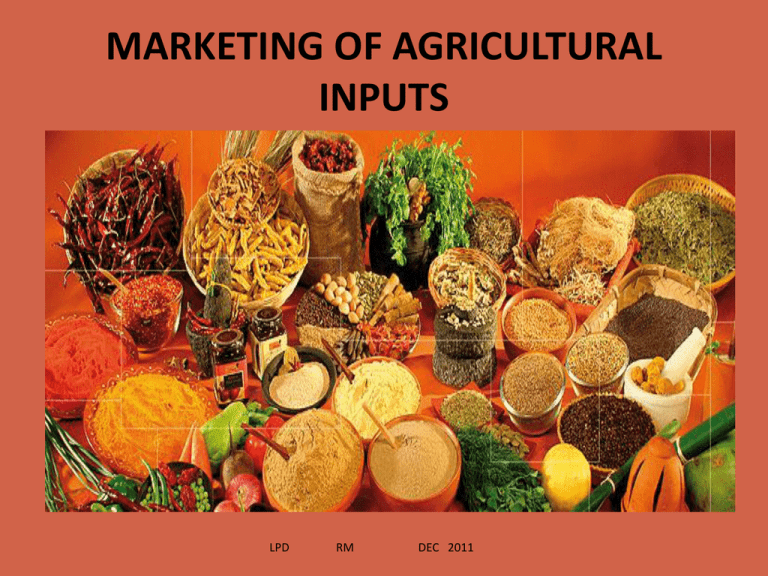MARKETING OF AGRICULTURAL INPUTS
advertisement

MARKETING OF AGRICULTURAL INPUTS LPD RM DEC 2011 • Though India is number 1 in the world in terms of irrigated land area, what worries the most is LOW PRODUCTIVITY. • Indian agricultural input could become uncompetitive in the long run if it fails to improve yield and quality if inputs. LPD RM DEC 2011 HOW TO IMPROVE PRODUCTIVITY? • Increase the level of MODERNIZATION of inputs. • MACHANIZATION • • • • • Do soil testing Get analysis done and then plan the crop Select the best fertilizers available in the market Try to use more organic inputs like compost Restructure the transportation problem LPD RM DEC 2011 SCINTIFIC METHODS • Increase the acidity by providing Zeolite which has the ability to increase soil PH without side effects • Add fertilizer containing Microbes,a friendly bacteria which absorbs N,P,K from air. • Provide manure compost which serves as a provider of food for bacteria and also for plants. LPD RM DEC 2011 Agricultural inputs 14/9/2011 5 TYPES OF INPUTS Agriculture input industry can be classified into 1. Consumables (That can be consumed: consumable energy. That may be depleted or worn out by use: consumable paper products. A consumable good or service: supplies of food, fuel, spare parts, and other consumables) 2. Durables (goods, such as most producer goods and some consumer goods, that require infrequent replacement ) LPD RM DEC 2011 CONSUMABLE INPUTS • Seeds.(high yield varieties) • Fertilizers.(manures) • Agrochemicals.(to protect plants from dieses, pests) • Oil and lubricants. • Cattle feed. • Veterinary medicines • Packing materials(gunnies, ,ropes,twine) LPD RM DEC 2011 DURABLE INPUTS • Tractors • Agricultural machineries (thrasher, harvester ) • Agricultural implements and tools (cultivators, levelers, irrigation, pump sets, motors, sheds, bullock carts, jeeps etc) LPD RM DEC 2011 MARKETING OF FERTILIZERS • Fertilizer is the most important among all the inputs purchased by the farmer. LPD RM DEC 2011 What made the marketing job of fertilizers important? • Application of fertilizers transformed the agriculture sector from being dependent on food grains imports to a stage of self sufficiency. • Availability of government subsidy • Lack sufficient use of fertilizers • Low production and productivity • Transformation from subsistence farming to enterprise farming LPD RM DEC 2011 FERTILIZER INDUSTRY IN INDIA • Single Super Phosphate (SSP) manufacturing unit was the first chemical fertilizer industry in Ranipet near Chennai with a capacity of 6000MT a year. • Indias Green Revolution in 1960s gave a positive boost to the sector • Presently India is the 3rd largest fertilizer producer in the world. LPD RM DEC 2011 -Contd• There are presently 57 large fertilizer plants in the country producing urea, DAP, complex fertilizer, ammonium sulphate and calcium ammonium nitrate. LPD RM DEC 2011 CLASSIFICATIONSOF FERTILIZER INDUSTRY • The grade of fertilizer is expressed in terms of nutrients-N,P,K for Nitrogen, Phosphate and Potassic fertilizers respectively • Consumption of these are steadily growing and they continue to grow creating lots of opportunities for the marketers LPD RM DEC 2011 MARKETING FOR FERTILIZER INDUSTRY • Fertilizer sector constitutes the backbone of Indian industry. • Government has played a very active role in the evolution, marketing and development of fertilizer industry in India. • Fertilizer is one of the most capital intensive industries, its marketing ecosystem is most complex in Indian context LPD RM DEC 2011 GOVERNAMENT REGULATIONS • UREA is one of the highly regulated industries in India • Prices, subsidies, distribution restrictions, imports, choice of technology , feeds stock are controlled and regulated by the government • Phosphatic and potassic fertilizers were decontrolled in august 1992 • Consumption of urea increased due to government subsidy LPD RM DEC 2011 • Government is selling urea at a subsidized price , if there were no subsidy the consumption pattern of chemical fertilizer would have been still very slow • Ministry of commercial and fertilizers ,DOF announced the nutrient based subsidy for complex fertilizers for the year 2012 LPD RM DEC 2011 DEVELOPMENTS IN INDIA • Refer table 18.4 for developments in fertilizer consumption in India -by Balaram Dogra and Karminder Ghuman, 1st Ed, The McGraw-Hill LPD RM DEC 2011 VARIATIONS IN CONSUMPTION • Variation across states. • Variation across districts. • Variation across product categories. LPD RM DEC 2011 VARIATIONS ACROSS STATES • States like Punjab, Haryana, AP, TN shows highest fertilizer consumption pattern • States like Rajasthan, Assam, Orissa shows lowest fertilizer consumption pattern • The consumption patterns of fertilizer has direct relevance to output pattern of crops. • States consuming more nutrients are producing more grain LPD RM DEC 2011 FERTILIZER MANUFACTURES IN INDIA • • • • • • PUBLIC SECTOR Chambal fertilizers FACT( fertilizers and chemicals Travancore) HCL(Hindustan copper Limited) SAIL Hindustan fertilizer corporation Ltd LPD RM DEC 2011 • CO-OPERATIVE SECTOR • IFFCO (Indian Farmers Fertilizer Cooperative limited) • PRIVATE SECTOR • Mangalore chemicals and fertilizers (MCF) • Nagarjuna fertilizers • Godavari fertilizers and chemicals etc LPD RM DEC 2011 Example of products of MCF LPD RM DEC 2011 • • • • • • • Products of MCF- Mangala Urea Mangala DAP Ammonium Bi Carbonate Mangala 20:20:00:13 Sulphuric Acid ChemCF NL ChemCF NP LPD RM DEC 2011 • Other Products: • Mangala MOP Specialty Fertilizers • Fertigation Products Soil Conditioners • Organic Products LPD RM DEC 2011 MCF PRODUCTS LPD RM DEC 2011 LPD RM DEC 2011 CHALLENGES FOR MARKETING OF FERTILIZER INDUSTRY • • • • • • • WTO guidelines Lack of irrigation Lack of availability of easy finance Limited availability of Natural gas Price hike of natural gas Unavailability of Raw materials Volatile international prices LPD RM DEC 2011 TRENDS • Water soluble fertilizers • Investments from technology providers and players • Increasing joint ventures LPD RM DEC 2011 COMPETETION • Market is highly competitive with major players batting for increased market share • Players are expanding production capacities and reviving their plants LPD RM DEC 2011 MARKETING STRATEGIES OF FERTILIZER INDUSTRY Promoting balanced and efficient use of fertilizers Demonstration Below line promotion activities (exhibitions, fair,competitions etc) Training programs for dealers Provision of value added services Use of information technology networks (kisan call centres) LPD RM DEC 2011 4 P’s of Fertilizers Product • Fertilizers fall in three categories based upon nutrientsNitrogenous(N), Phosphates(P), Potassic (K) which are being supplied to crops. 1. Straight fertilizers – supply single nutrient E.g. – ammonium sulphate, urea, calcium ammonium, nitrate, single super phosphate. 2. Compound fertilizers – which contain more than one nutrient E.g. – Di-Ammonium Phosphate(DAP) complex fertilizer contains nitrogen and phosphate. 3. NPK fertilizers which has all three nutrients. 4. Fertilizers as per Fertilizer Control Order (FCO) marketed only by generic name and not by trade or brand name. 5. Each bag should show proportions of 3 nutrients NPK. 14/9/2011 31 Price • . Till 1991 the Govt. of India fixed the prices of different grades of fertilizers • From June 1994 except Urea fertilizer all other were decontrolled. • Decontrol was to reduce burden of subsidies on the Govt. It provided subsidies on adhoc. • Rate of subsidies varies across countries and types of fertilizers. • Fertilizer subsidy is to provide fertilizers to the farmers at lower prices than its economic prices. Place • 2,75,000 outlets selling fertilizers in the country. • 70% private sector & 30% cooperatives societies and public sector like State Agro Industries Corporations. • Manufacturers store inventory in regional godowns maintained by them and then released to wholesalers and then to retailers during season. • Manufacturers like Indian Farmers Fertilizer Cooperative Ltd. (IFFCO) , Gujarat State Fertilizer & Chemicals Ltd. (GSFC), Fertilizers & Chemicals Travancore Ltd. (FACT) maintain their own outlets. Promotion • Manufacturers use their own promotional measures and create brand image. • Inter-personal and group contacts • Fertilizer festivals and Kissan Melas • TV • Newspapers and Journals • Special promotional measures • Village Adoption Programme • Wall Paintings and Hoardings 34 POLICIES FOR MARKETING OF FERTILIZERS LPD RM DEC 2011 Retention Pricing scheme •Introduced in 1997 , to keep the prices low. •Cost plus subsidy paid to urea manufacturers to compensate. Distribution Policy • Earlier only determined by Government but now there are many private selling points also. • There are 2,72,000 fertilizers sales point presently. Import policy • Import of fertilizer i.e UREA which is used at very large scale is on restricted list. • Prices are fixed in such a way that there is no difference in price of fertilizers either imported or bought from domestic market LPD RM DEC 2011 INDIAN AGROCHEMICAL INDUSTRY • Constitutes those chemical compounds that prevent crops from attack of pests , weeds , fungus , insects and other related diseases. •Classification is on the basis of the purpose for which it is used i.e insecticides , fungicides etc •India is second largest producer of agrochemicals in world after Japan. LPD RM DEC 2011 PRODUCT CATEGERIES • • • • INSECTICIDES HERBICIDES FUNGICIDES PESTICIDES LPD RM DEC 2011 • Insecticides are the largest product sector amongst agrochemicals in India contributing 75% of the total market (Also MNCs Money making area) • Herbicides account for the 12% of the total Indian agrochemical market • Fungicides account for 10% of the total agrochemical market LPD RM DEC 2011 MARKETING ENVIRONMENT FOR AGROCHEMICALS IN INDIA The marketing environment for agrochemicals depends on following factors 1. Cropping pattern 2. Government policies and regulations 3. Factors affecting market growth 4. Factors creating challenges and threat for the industry LPD RM DEC 2011 • CROPPING PATTERNS • GOVERNMENT POLICIES AND REGULATIONS • Farmers dependent monsoons , limits possibilities of high investment on agrochemicals. • Agrochemical market is different for different crops and different states . • Eg: for cotton in south 12-15 sprays are required whereas in north only 6-10. • Economic liberalization had major impact. • Reduction in import tariffs. • De licensing in pesticide industry. • Opportunity for exports LPD RM DEC 2011 MARKETING ENVIRONMENT FOR AGROCHEMICALS IN INDIA LPD RM DEC 2011 FACTORS EFFECTING AGROCHEMICAL'S MARKET GROWTH Farmers incomes are rising Aggressive promotion Backward integration Usage of agrochemicals is increasing New and effective products are reaching Indian markets Irrigated area is rising because of corporate irrigation LPD RM DEC 2011 CHALLENGES FACED BY INDIAN AGROCHEMICAL INDUSTRY Low profit margins Crop imbalance ( optimum consumption is difficult to realize , crops need less or more chemicals) Regional imbalance Low selling price of agricultural products Natural calamities Environmental pressures (critics) LPD RM DEC 2011 MARKETING STRATEGIES FOR AGROCHEMICALS PRODUCT STRATEGY The formulators are free to manufacture and market any combination of insecticides or pesticides from the basic chemicals PRICES STRATEGY Aggressive distribution strategy by dealing directly with retailer. The competition guides the prices Effectiveness of certain brands gets the advantage of premium pricing LPD RM DEC 2011 PLACES STRATEGY High MRP and low selling price Good working capital management (limited credit) PROMOTION STRATEGY Promotional efforts to change attitude (exhibitions , melas) Farmer education LPD RM DEC 2011 EXPORT STRATEGY In order to safeguard industry from unpredictable losses from domestic market Indian firms should consider whole world as its market.(already considering too) LPD RM DEC 2011 MARKETING OF FEEDS FOR LIVESTOCK LPD RM DEC 2011 • Sale of feeds for consumption of cows, bullocks, buffalos, and feeds for poultry, fish etc is a fast growing business. • Dairying is a very big business activity and for this purpose food and care of cows and buffaloes is essential. • For poultry, fish and shrimps, some units make and sell special packed feed • In coastal areas, locally cultivated fish, shrimps, are used as feeds. LPD RM DEC 2011 SEEDS MARKETING LPD RM DEC 2011 • Seed is the most essential input and hence not much of marketing effort is required • Marketers job is only when new varieties come • Another explanation require is quantity required per acre and the quantum of crops expected from a particular variety. • Earlier seeds marketing was done by government due to mal practices LPD RM DEC 2011 SEEDS MANUFACTURERS FROM PRIVATE SECTORS. ITC. HUL. Thapar Group. Pioneer Group. LPD RM DEC 2011 LPD RM DEC 2011 LPD RM DEC 2011 LPD RM DEC 2011 Retail outlet in a fair LPD RM DEC 2011 Pushkar Fair (Camel sale) of Rajasthan LPD RM DEC 2011 Retail outlet in a rural fair LPD RM DEC 2011 LPD RM DEC 2011





